Organizational Behavior: Theories, Practices, and Employee Motivation
VerifiedAdded on 2020/05/16
|7
|2190
|176
Essay
AI Summary
This essay delves into the core concepts of organizational behavior, emphasizing its significance in enhancing firm productivity. It highlights the importance of understanding employee behavior, motivations, and emotional aspects to effectively manage and guide them toward shared objectives. The essay explores various theories related to organizational behavior, including job design, leadership styles, ethical considerations, goal setting, and employee motivation. It discusses how these factors impact employee performance, satisfaction, and commitment. The study also examines the challenges faced by organizations in adapting to diverse work cultures and the role of managers in creating a positive and productive work environment. The essay references several academic sources to support its arguments, providing a comprehensive overview of organizational behavior and its practical applications.
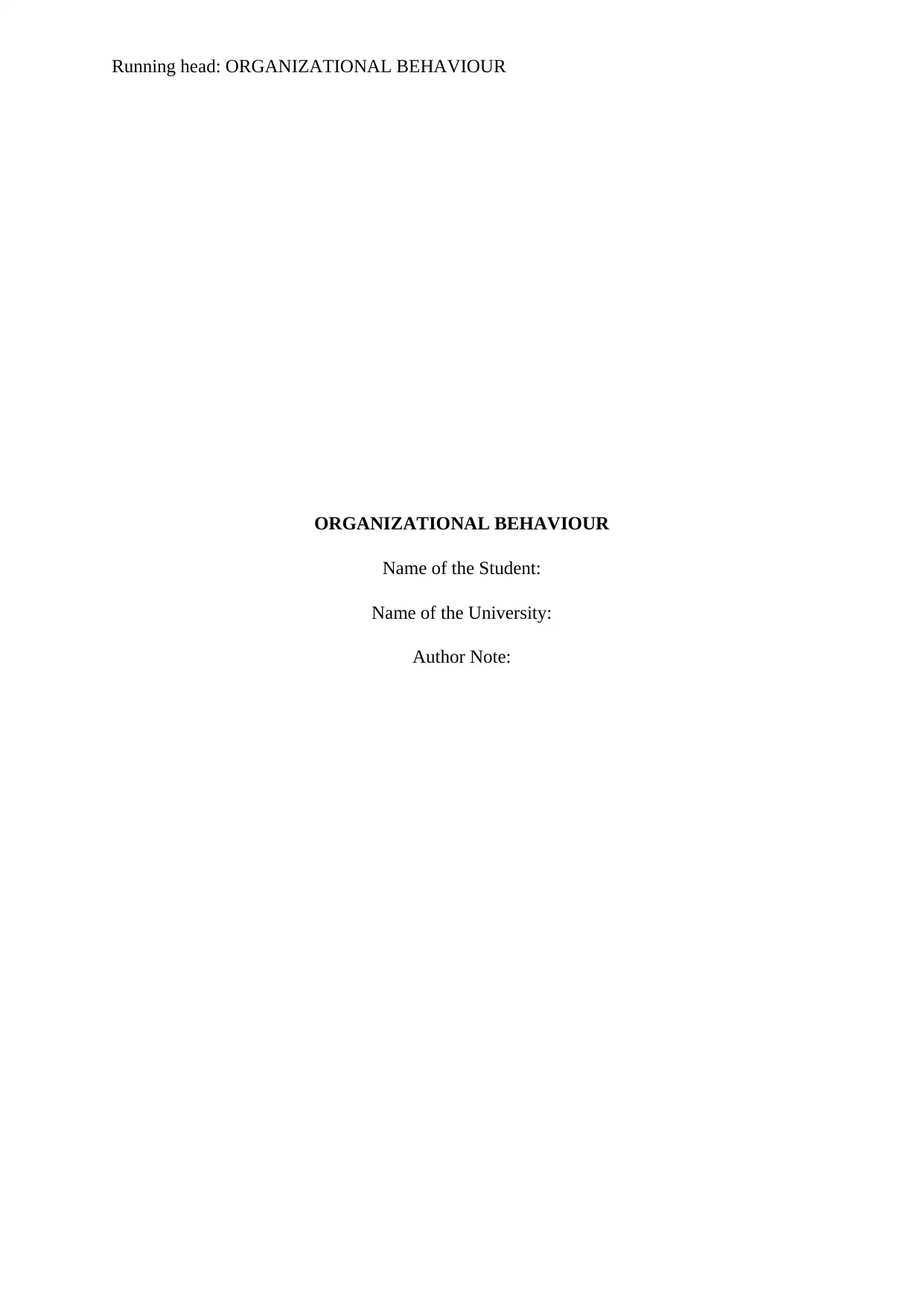
Running head: ORGANIZATIONAL BEHAVIOUR
ORGANIZATIONAL BEHAVIOUR
Name of the Student:
Name of the University:
Author Note:
ORGANIZATIONAL BEHAVIOUR
Name of the Student:
Name of the University:
Author Note:
Paraphrase This Document
Need a fresh take? Get an instant paraphrase of this document with our AI Paraphraser
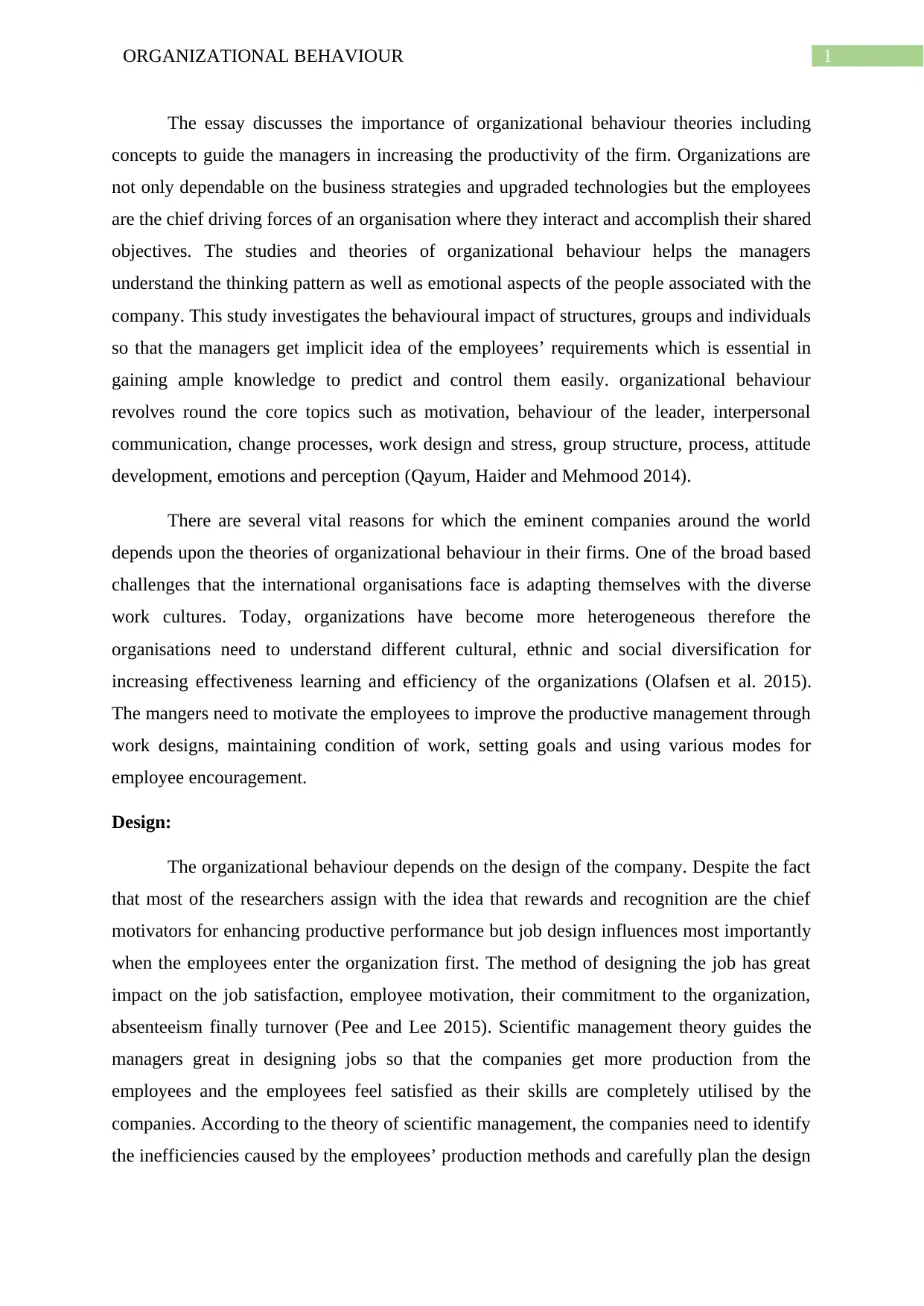
1ORGANIZATIONAL BEHAVIOUR
The essay discusses the importance of organizational behaviour theories including
concepts to guide the managers in increasing the productivity of the firm. Organizations are
not only dependable on the business strategies and upgraded technologies but the employees
are the chief driving forces of an organisation where they interact and accomplish their shared
objectives. The studies and theories of organizational behaviour helps the managers
understand the thinking pattern as well as emotional aspects of the people associated with the
company. This study investigates the behavioural impact of structures, groups and individuals
so that the managers get implicit idea of the employees’ requirements which is essential in
gaining ample knowledge to predict and control them easily. organizational behaviour
revolves round the core topics such as motivation, behaviour of the leader, interpersonal
communication, change processes, work design and stress, group structure, process, attitude
development, emotions and perception (Qayum, Haider and Mehmood 2014).
There are several vital reasons for which the eminent companies around the world
depends upon the theories of organizational behaviour in their firms. One of the broad based
challenges that the international organisations face is adapting themselves with the diverse
work cultures. Today, organizations have become more heterogeneous therefore the
organisations need to understand different cultural, ethnic and social diversification for
increasing effectiveness learning and efficiency of the organizations (Olafsen et al. 2015).
The mangers need to motivate the employees to improve the productive management through
work designs, maintaining condition of work, setting goals and using various modes for
employee encouragement.
Design:
The organizational behaviour depends on the design of the company. Despite the fact
that most of the researchers assign with the idea that rewards and recognition are the chief
motivators for enhancing productive performance but job design influences most importantly
when the employees enter the organization first. The method of designing the job has great
impact on the job satisfaction, employee motivation, their commitment to the organization,
absenteeism finally turnover (Pee and Lee 2015). Scientific management theory guides the
managers great in designing jobs so that the companies get more production from the
employees and the employees feel satisfied as their skills are completely utilised by the
companies. According to the theory of scientific management, the companies need to identify
the inefficiencies caused by the employees’ production methods and carefully plan the design
The essay discusses the importance of organizational behaviour theories including
concepts to guide the managers in increasing the productivity of the firm. Organizations are
not only dependable on the business strategies and upgraded technologies but the employees
are the chief driving forces of an organisation where they interact and accomplish their shared
objectives. The studies and theories of organizational behaviour helps the managers
understand the thinking pattern as well as emotional aspects of the people associated with the
company. This study investigates the behavioural impact of structures, groups and individuals
so that the managers get implicit idea of the employees’ requirements which is essential in
gaining ample knowledge to predict and control them easily. organizational behaviour
revolves round the core topics such as motivation, behaviour of the leader, interpersonal
communication, change processes, work design and stress, group structure, process, attitude
development, emotions and perception (Qayum, Haider and Mehmood 2014).
There are several vital reasons for which the eminent companies around the world
depends upon the theories of organizational behaviour in their firms. One of the broad based
challenges that the international organisations face is adapting themselves with the diverse
work cultures. Today, organizations have become more heterogeneous therefore the
organisations need to understand different cultural, ethnic and social diversification for
increasing effectiveness learning and efficiency of the organizations (Olafsen et al. 2015).
The mangers need to motivate the employees to improve the productive management through
work designs, maintaining condition of work, setting goals and using various modes for
employee encouragement.
Design:
The organizational behaviour depends on the design of the company. Despite the fact
that most of the researchers assign with the idea that rewards and recognition are the chief
motivators for enhancing productive performance but job design influences most importantly
when the employees enter the organization first. The method of designing the job has great
impact on the job satisfaction, employee motivation, their commitment to the organization,
absenteeism finally turnover (Pee and Lee 2015). Scientific management theory guides the
managers great in designing jobs so that the companies get more production from the
employees and the employees feel satisfied as their skills are completely utilised by the
companies. According to the theory of scientific management, the companies need to identify
the inefficiencies caused by the employees’ production methods and carefully plan the design
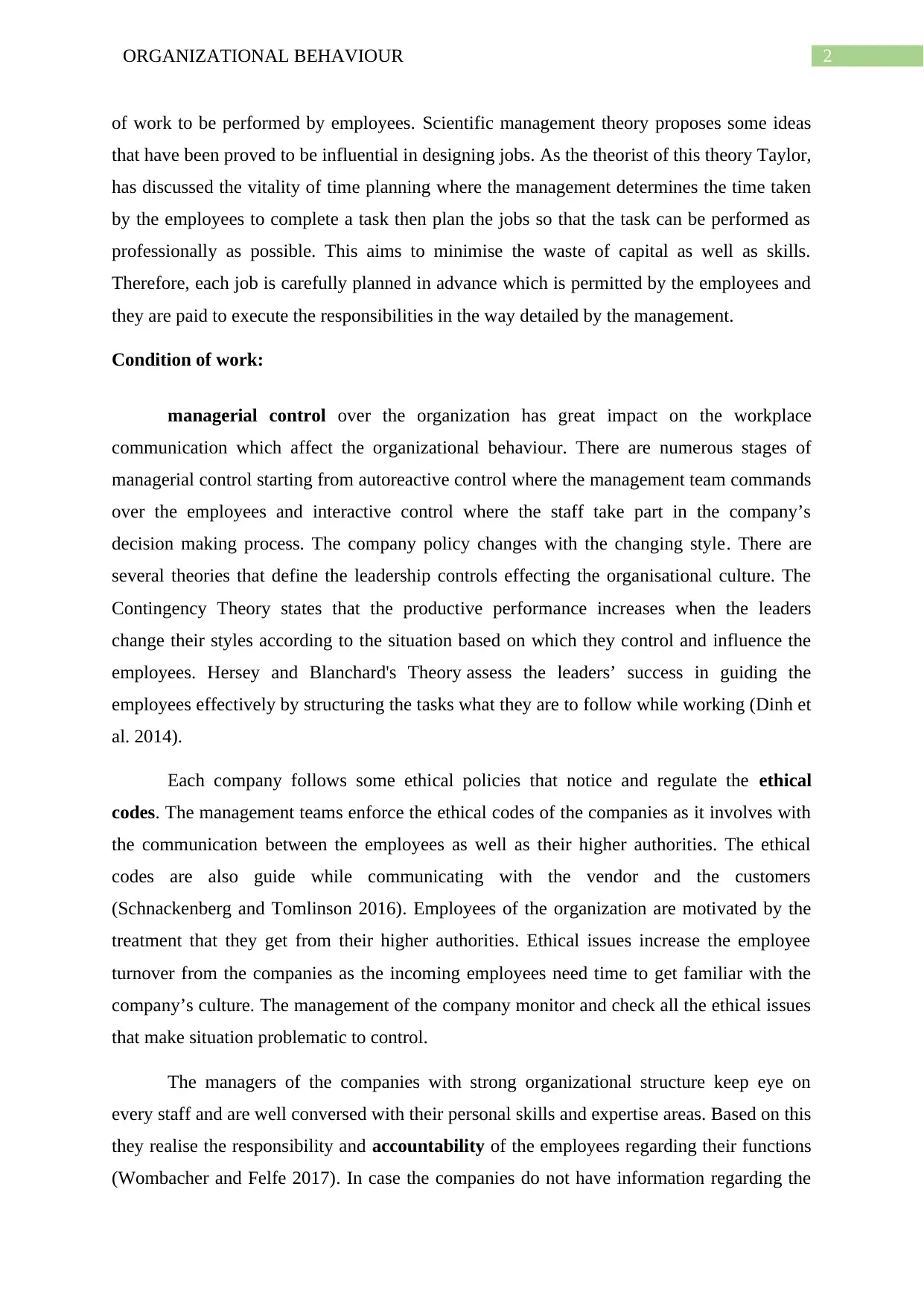
2ORGANIZATIONAL BEHAVIOUR
of work to be performed by employees. Scientific management theory proposes some ideas
that have been proved to be influential in designing jobs. As the theorist of this theory Taylor,
has discussed the vitality of time planning where the management determines the time taken
by the employees to complete a task then plan the jobs so that the task can be performed as
professionally as possible. This aims to minimise the waste of capital as well as skills.
Therefore, each job is carefully planned in advance which is permitted by the employees and
they are paid to execute the responsibilities in the way detailed by the management.
Condition of work:
managerial control over the organization has great impact on the workplace
communication which affect the organizational behaviour. There are numerous stages of
managerial control starting from autoreactive control where the management team commands
over the employees and interactive control where the staff take part in the company’s
decision making process. The company policy changes with the changing style. There are
several theories that define the leadership controls effecting the organisational culture. The
Contingency Theory states that the productive performance increases when the leaders
change their styles according to the situation based on which they control and influence the
employees. Hersey and Blanchard's Theory assess the leaders’ success in guiding the
employees effectively by structuring the tasks what they are to follow while working (Dinh et
al. 2014).
Each company follows some ethical policies that notice and regulate the ethical
codes. The management teams enforce the ethical codes of the companies as it involves with
the communication between the employees as well as their higher authorities. The ethical
codes are also guide while communicating with the vendor and the customers
(Schnackenberg and Tomlinson 2016). Employees of the organization are motivated by the
treatment that they get from their higher authorities. Ethical issues increase the employee
turnover from the companies as the incoming employees need time to get familiar with the
company’s culture. The management of the company monitor and check all the ethical issues
that make situation problematic to control.
The managers of the companies with strong organizational structure keep eye on
every staff and are well conversed with their personal skills and expertise areas. Based on this
they realise the responsibility and accountability of the employees regarding their functions
(Wombacher and Felfe 2017). In case the companies do not have information regarding the
of work to be performed by employees. Scientific management theory proposes some ideas
that have been proved to be influential in designing jobs. As the theorist of this theory Taylor,
has discussed the vitality of time planning where the management determines the time taken
by the employees to complete a task then plan the jobs so that the task can be performed as
professionally as possible. This aims to minimise the waste of capital as well as skills.
Therefore, each job is carefully planned in advance which is permitted by the employees and
they are paid to execute the responsibilities in the way detailed by the management.
Condition of work:
managerial control over the organization has great impact on the workplace
communication which affect the organizational behaviour. There are numerous stages of
managerial control starting from autoreactive control where the management team commands
over the employees and interactive control where the staff take part in the company’s
decision making process. The company policy changes with the changing style. There are
several theories that define the leadership controls effecting the organisational culture. The
Contingency Theory states that the productive performance increases when the leaders
change their styles according to the situation based on which they control and influence the
employees. Hersey and Blanchard's Theory assess the leaders’ success in guiding the
employees effectively by structuring the tasks what they are to follow while working (Dinh et
al. 2014).
Each company follows some ethical policies that notice and regulate the ethical
codes. The management teams enforce the ethical codes of the companies as it involves with
the communication between the employees as well as their higher authorities. The ethical
codes are also guide while communicating with the vendor and the customers
(Schnackenberg and Tomlinson 2016). Employees of the organization are motivated by the
treatment that they get from their higher authorities. Ethical issues increase the employee
turnover from the companies as the incoming employees need time to get familiar with the
company’s culture. The management of the company monitor and check all the ethical issues
that make situation problematic to control.
The managers of the companies with strong organizational structure keep eye on
every staff and are well conversed with their personal skills and expertise areas. Based on this
they realise the responsibility and accountability of the employees regarding their functions
(Wombacher and Felfe 2017). In case the companies do not have information regarding the
⊘ This is a preview!⊘
Do you want full access?
Subscribe today to unlock all pages.

Trusted by 1+ million students worldwide

3ORGANIZATIONAL BEHAVIOUR
accountability for success as well as failure they do not get scope for rewarding productivity
as well as punish those who are responsible to take the organizations to bottom line in
performance.
The organizational behaviour includes the employee mistreatment such as bullying,
incivility, abusive supervision, discrimination and sexual harassment. Due to these negative
work culture, productive performance gets hampered. No organization is free from these
kinds of unwanted conduct or intimidation problems (Dutcher et al. 2015). These issues are
addressed with proper trainings, diligence and policies. The Big Five Model of Personality
Dimensions guide the management to response these problems in the originations.
Goal setting:
Goal setting theory is one of the most influential as well as practical theories to
improve performances. To enhance the company’s reputation based on their product and
services the management essentially set goals or objectives based on which they motivate and
guide their employees to perform. According to the goal setting theory, the goals are aims of
an actions (Blaskova, Bizik and Jankal 2015). In order to attain proficiency in a particular
time span, the management of an organization predicts, explains then influences the
performance of their employees. Reinforcement Theory directly contrasts the goal setting
theory where the latter identifies the purpose of the individuals directs their behaviour. It
focuses on the connection between conscious performance goals and level of work
performance rather than on separate intentions to take particular actions.
The theorists have point out that SMART goals features specific and measureable
characteristics, these are aggressive yet realistic as well as time bound. These goal setting
help the organizations by providing them directions on which the management focus on.
They acquire knowledge from the feedbacks of the employees, judge their abilities to reach
the goals and check how committed the employees are to their objectives.
Setting specific and clear goals for accomplishing a particular task increases
efficiency of the employees which ultimately leads to confidence. It gives rise to feeling of
price as attained and prepares oneself to achieve the next goal (Blaskova, Bizik and Jankal
2015). Thus the organizational culture gets uplifted and the employees feel passionate about
their tasks.
Motivation:
accountability for success as well as failure they do not get scope for rewarding productivity
as well as punish those who are responsible to take the organizations to bottom line in
performance.
The organizational behaviour includes the employee mistreatment such as bullying,
incivility, abusive supervision, discrimination and sexual harassment. Due to these negative
work culture, productive performance gets hampered. No organization is free from these
kinds of unwanted conduct or intimidation problems (Dutcher et al. 2015). These issues are
addressed with proper trainings, diligence and policies. The Big Five Model of Personality
Dimensions guide the management to response these problems in the originations.
Goal setting:
Goal setting theory is one of the most influential as well as practical theories to
improve performances. To enhance the company’s reputation based on their product and
services the management essentially set goals or objectives based on which they motivate and
guide their employees to perform. According to the goal setting theory, the goals are aims of
an actions (Blaskova, Bizik and Jankal 2015). In order to attain proficiency in a particular
time span, the management of an organization predicts, explains then influences the
performance of their employees. Reinforcement Theory directly contrasts the goal setting
theory where the latter identifies the purpose of the individuals directs their behaviour. It
focuses on the connection between conscious performance goals and level of work
performance rather than on separate intentions to take particular actions.
The theorists have point out that SMART goals features specific and measureable
characteristics, these are aggressive yet realistic as well as time bound. These goal setting
help the organizations by providing them directions on which the management focus on.
They acquire knowledge from the feedbacks of the employees, judge their abilities to reach
the goals and check how committed the employees are to their objectives.
Setting specific and clear goals for accomplishing a particular task increases
efficiency of the employees which ultimately leads to confidence. It gives rise to feeling of
price as attained and prepares oneself to achieve the next goal (Blaskova, Bizik and Jankal
2015). Thus the organizational culture gets uplifted and the employees feel passionate about
their tasks.
Motivation:
Paraphrase This Document
Need a fresh take? Get an instant paraphrase of this document with our AI Paraphraser
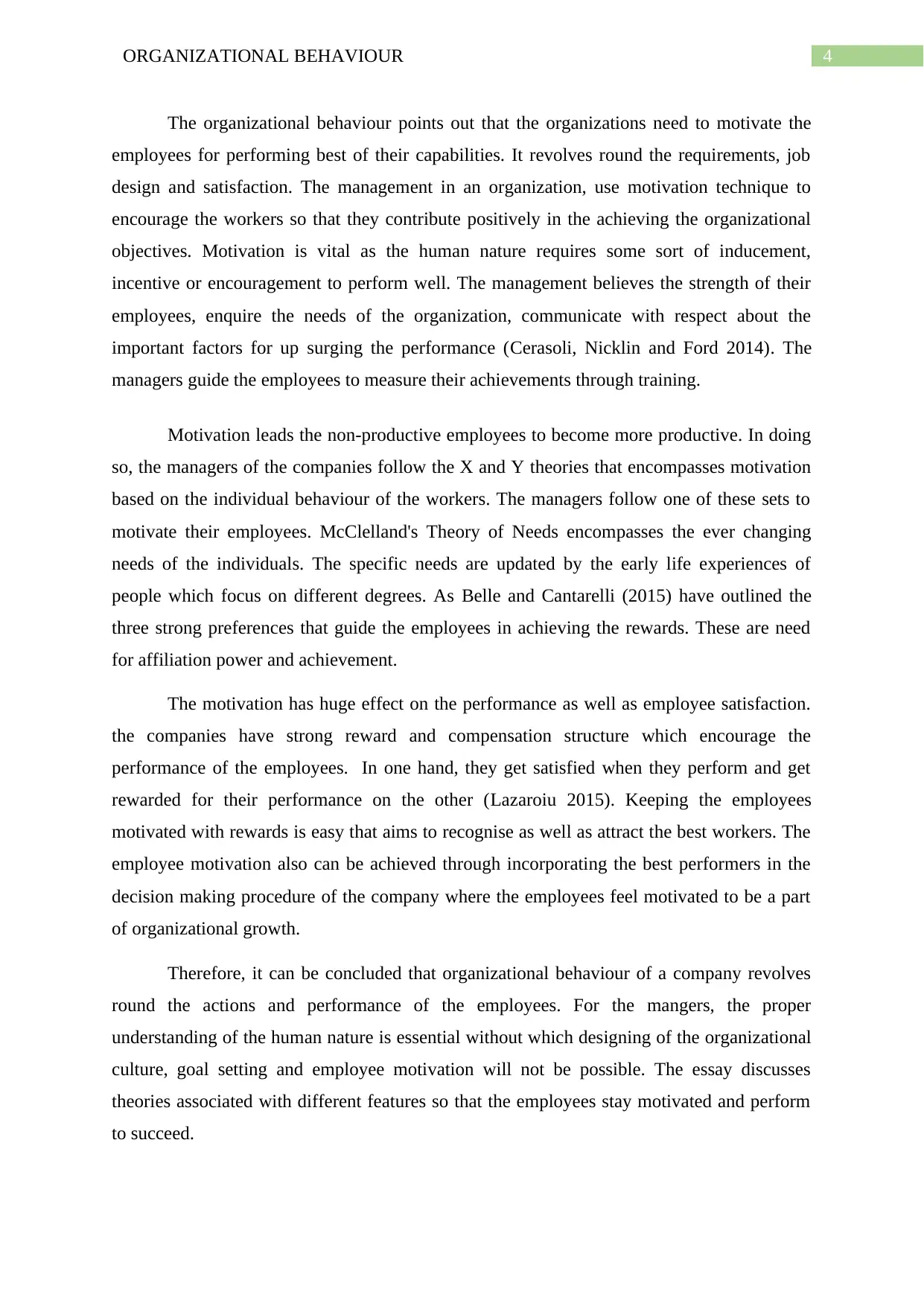
4ORGANIZATIONAL BEHAVIOUR
The organizational behaviour points out that the organizations need to motivate the
employees for performing best of their capabilities. It revolves round the requirements, job
design and satisfaction. The management in an organization, use motivation technique to
encourage the workers so that they contribute positively in the achieving the organizational
objectives. Motivation is vital as the human nature requires some sort of inducement,
incentive or encouragement to perform well. The management believes the strength of their
employees, enquire the needs of the organization, communicate with respect about the
important factors for up surging the performance (Cerasoli, Nicklin and Ford 2014). The
managers guide the employees to measure their achievements through training.
Motivation leads the non-productive employees to become more productive. In doing
so, the managers of the companies follow the X and Y theories that encompasses motivation
based on the individual behaviour of the workers. The managers follow one of these sets to
motivate their employees. McClelland's Theory of Needs encompasses the ever changing
needs of the individuals. The specific needs are updated by the early life experiences of
people which focus on different degrees. As Belle and Cantarelli (2015) have outlined the
three strong preferences that guide the employees in achieving the rewards. These are need
for affiliation power and achievement.
The motivation has huge effect on the performance as well as employee satisfaction.
the companies have strong reward and compensation structure which encourage the
performance of the employees. In one hand, they get satisfied when they perform and get
rewarded for their performance on the other (Lazaroiu 2015). Keeping the employees
motivated with rewards is easy that aims to recognise as well as attract the best workers. The
employee motivation also can be achieved through incorporating the best performers in the
decision making procedure of the company where the employees feel motivated to be a part
of organizational growth.
Therefore, it can be concluded that organizational behaviour of a company revolves
round the actions and performance of the employees. For the mangers, the proper
understanding of the human nature is essential without which designing of the organizational
culture, goal setting and employee motivation will not be possible. The essay discusses
theories associated with different features so that the employees stay motivated and perform
to succeed.
The organizational behaviour points out that the organizations need to motivate the
employees for performing best of their capabilities. It revolves round the requirements, job
design and satisfaction. The management in an organization, use motivation technique to
encourage the workers so that they contribute positively in the achieving the organizational
objectives. Motivation is vital as the human nature requires some sort of inducement,
incentive or encouragement to perform well. The management believes the strength of their
employees, enquire the needs of the organization, communicate with respect about the
important factors for up surging the performance (Cerasoli, Nicklin and Ford 2014). The
managers guide the employees to measure their achievements through training.
Motivation leads the non-productive employees to become more productive. In doing
so, the managers of the companies follow the X and Y theories that encompasses motivation
based on the individual behaviour of the workers. The managers follow one of these sets to
motivate their employees. McClelland's Theory of Needs encompasses the ever changing
needs of the individuals. The specific needs are updated by the early life experiences of
people which focus on different degrees. As Belle and Cantarelli (2015) have outlined the
three strong preferences that guide the employees in achieving the rewards. These are need
for affiliation power and achievement.
The motivation has huge effect on the performance as well as employee satisfaction.
the companies have strong reward and compensation structure which encourage the
performance of the employees. In one hand, they get satisfied when they perform and get
rewarded for their performance on the other (Lazaroiu 2015). Keeping the employees
motivated with rewards is easy that aims to recognise as well as attract the best workers. The
employee motivation also can be achieved through incorporating the best performers in the
decision making procedure of the company where the employees feel motivated to be a part
of organizational growth.
Therefore, it can be concluded that organizational behaviour of a company revolves
round the actions and performance of the employees. For the mangers, the proper
understanding of the human nature is essential without which designing of the organizational
culture, goal setting and employee motivation will not be possible. The essay discusses
theories associated with different features so that the employees stay motivated and perform
to succeed.
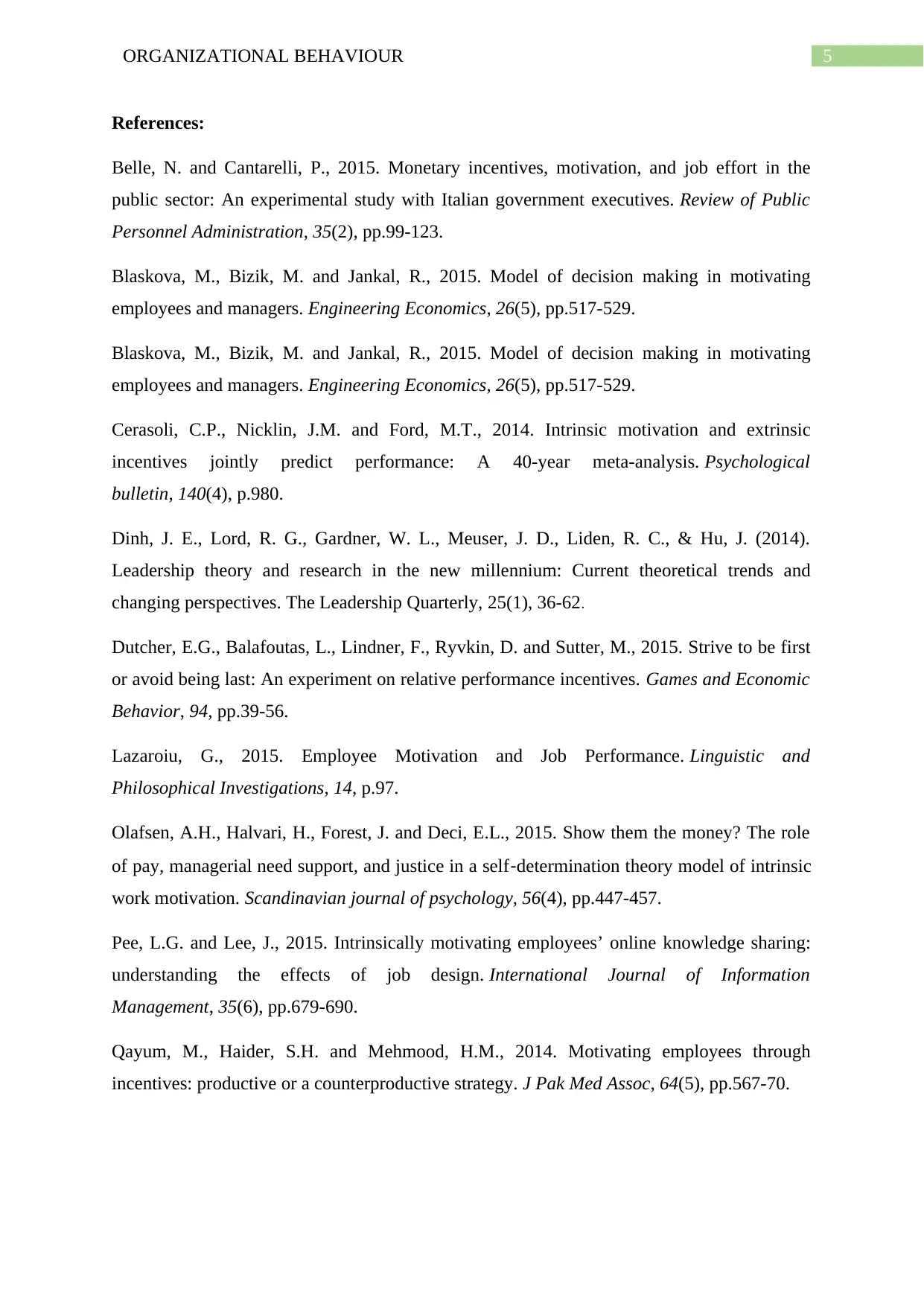
5ORGANIZATIONAL BEHAVIOUR
References:
Belle, N. and Cantarelli, P., 2015. Monetary incentives, motivation, and job effort in the
public sector: An experimental study with Italian government executives. Review of Public
Personnel Administration, 35(2), pp.99-123.
Blaskova, M., Bizik, M. and Jankal, R., 2015. Model of decision making in motivating
employees and managers. Engineering Economics, 26(5), pp.517-529.
Blaskova, M., Bizik, M. and Jankal, R., 2015. Model of decision making in motivating
employees and managers. Engineering Economics, 26(5), pp.517-529.
Cerasoli, C.P., Nicklin, J.M. and Ford, M.T., 2014. Intrinsic motivation and extrinsic
incentives jointly predict performance: A 40-year meta-analysis. Psychological
bulletin, 140(4), p.980.
Dinh, J. E., Lord, R. G., Gardner, W. L., Meuser, J. D., Liden, R. C., & Hu, J. (2014).
Leadership theory and research in the new millennium: Current theoretical trends and
changing perspectives. The Leadership Quarterly, 25(1), 36-62.
Dutcher, E.G., Balafoutas, L., Lindner, F., Ryvkin, D. and Sutter, M., 2015. Strive to be first
or avoid being last: An experiment on relative performance incentives. Games and Economic
Behavior, 94, pp.39-56.
Lazaroiu, G., 2015. Employee Motivation and Job Performance. Linguistic and
Philosophical Investigations, 14, p.97.
Olafsen, A.H., Halvari, H., Forest, J. and Deci, E.L., 2015. Show them the money? The role
of pay, managerial need support, and justice in a self‐determination theory model of intrinsic
work motivation. Scandinavian journal of psychology, 56(4), pp.447-457.
Pee, L.G. and Lee, J., 2015. Intrinsically motivating employees’ online knowledge sharing:
understanding the effects of job design. International Journal of Information
Management, 35(6), pp.679-690.
Qayum, M., Haider, S.H. and Mehmood, H.M., 2014. Motivating employees through
incentives: productive or a counterproductive strategy. J Pak Med Assoc, 64(5), pp.567-70.
References:
Belle, N. and Cantarelli, P., 2015. Monetary incentives, motivation, and job effort in the
public sector: An experimental study with Italian government executives. Review of Public
Personnel Administration, 35(2), pp.99-123.
Blaskova, M., Bizik, M. and Jankal, R., 2015. Model of decision making in motivating
employees and managers. Engineering Economics, 26(5), pp.517-529.
Blaskova, M., Bizik, M. and Jankal, R., 2015. Model of decision making in motivating
employees and managers. Engineering Economics, 26(5), pp.517-529.
Cerasoli, C.P., Nicklin, J.M. and Ford, M.T., 2014. Intrinsic motivation and extrinsic
incentives jointly predict performance: A 40-year meta-analysis. Psychological
bulletin, 140(4), p.980.
Dinh, J. E., Lord, R. G., Gardner, W. L., Meuser, J. D., Liden, R. C., & Hu, J. (2014).
Leadership theory and research in the new millennium: Current theoretical trends and
changing perspectives. The Leadership Quarterly, 25(1), 36-62.
Dutcher, E.G., Balafoutas, L., Lindner, F., Ryvkin, D. and Sutter, M., 2015. Strive to be first
or avoid being last: An experiment on relative performance incentives. Games and Economic
Behavior, 94, pp.39-56.
Lazaroiu, G., 2015. Employee Motivation and Job Performance. Linguistic and
Philosophical Investigations, 14, p.97.
Olafsen, A.H., Halvari, H., Forest, J. and Deci, E.L., 2015. Show them the money? The role
of pay, managerial need support, and justice in a self‐determination theory model of intrinsic
work motivation. Scandinavian journal of psychology, 56(4), pp.447-457.
Pee, L.G. and Lee, J., 2015. Intrinsically motivating employees’ online knowledge sharing:
understanding the effects of job design. International Journal of Information
Management, 35(6), pp.679-690.
Qayum, M., Haider, S.H. and Mehmood, H.M., 2014. Motivating employees through
incentives: productive or a counterproductive strategy. J Pak Med Assoc, 64(5), pp.567-70.
⊘ This is a preview!⊘
Do you want full access?
Subscribe today to unlock all pages.

Trusted by 1+ million students worldwide
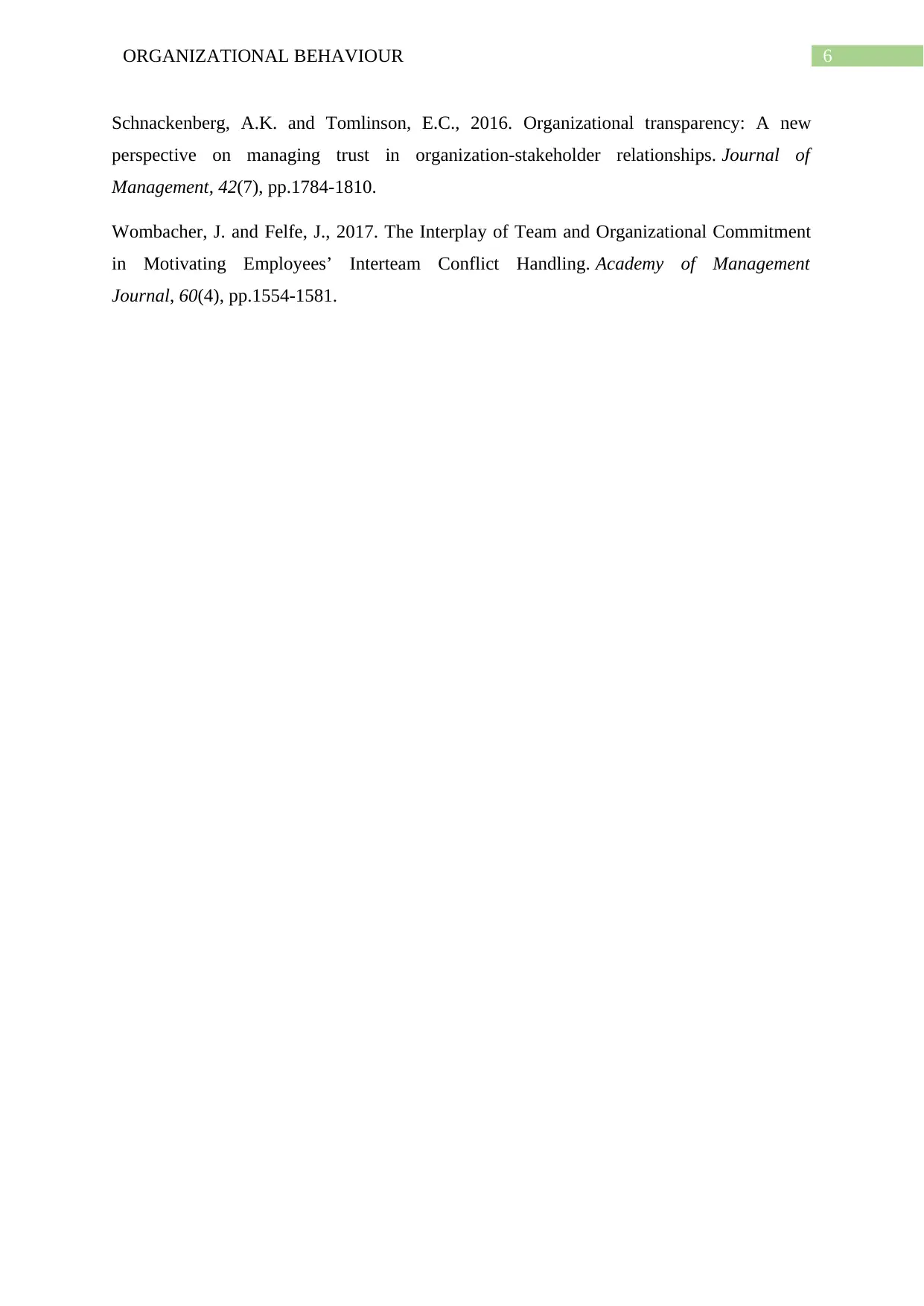
6ORGANIZATIONAL BEHAVIOUR
Schnackenberg, A.K. and Tomlinson, E.C., 2016. Organizational transparency: A new
perspective on managing trust in organization-stakeholder relationships. Journal of
Management, 42(7), pp.1784-1810.
Wombacher, J. and Felfe, J., 2017. The Interplay of Team and Organizational Commitment
in Motivating Employees’ Interteam Conflict Handling. Academy of Management
Journal, 60(4), pp.1554-1581.
Schnackenberg, A.K. and Tomlinson, E.C., 2016. Organizational transparency: A new
perspective on managing trust in organization-stakeholder relationships. Journal of
Management, 42(7), pp.1784-1810.
Wombacher, J. and Felfe, J., 2017. The Interplay of Team and Organizational Commitment
in Motivating Employees’ Interteam Conflict Handling. Academy of Management
Journal, 60(4), pp.1554-1581.
1 out of 7
Related Documents
Your All-in-One AI-Powered Toolkit for Academic Success.
+13062052269
info@desklib.com
Available 24*7 on WhatsApp / Email
![[object Object]](/_next/static/media/star-bottom.7253800d.svg)
Unlock your academic potential
Copyright © 2020–2025 A2Z Services. All Rights Reserved. Developed and managed by ZUCOL.




